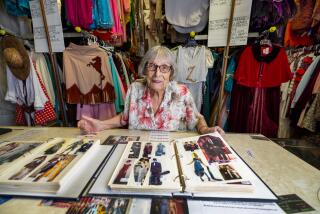A curious task, however you slice it
- Share via
Fortunately, requests to preserve clothing made out of raw meat are rare, Sergio Vigilato admits.
But when the Burbank taxidermist got the call to turn Lady Gaga’s infamous Argentinean beef gown into a museum display, he bit at the opportunity.
Vigilato was contacted by the Rock and Roll Hall of Fame and Museum two months after the pop singer wore the meat dress on stage Sept. 12, 2010, to accept the trophy for the year’s best music video at the MTV Video Music Awards.
“The first thing I asked was, ‘Where is the dress? This thing could have maggots by now,’ ” Vigilato said. “I understood them to say it was in a room with air conditioning. I said make sure it’s in a freezer.”
Actually, the 35-pound dress made of a dozen thin-cut flank steaks was being kept on ice. It was frozen stiff — and maggot-free — when it was delivered to Vigilato’s American Taxidermy shop 3 1/2 weeks later.
As he defrosted it, Vigilato found that the dress had begun decomposing before it had been frozen. As it thawed out, it developed an odor.
“But the Rock and Roll museum had already paid me upfront — $6,000 — so I went ahead with it,” he said. It took more than a month to clean and preserve the meat.
Vigilato declined to reveal the process he used to cure the meat dress, although museum officials said it was treated with bleach, formaldehyde and detergent to remove bacteria.
Once the meat was preserved, Vigilato said, he had to recondition it to make it semi-pliable so it could be reassembled into the dress originally created by Los Angeles artist and designer Franc Fernandez and stylist Nicola Formichetti.
He glued the meat slabs to a mannequin outfitted with a pattern cut to resemble Fernandez’s original dress and then dyed it a dark red to resemble its color when Lady Gaga wore it. He boxed it up and shipped it May 20 to the museum in Cleveland.
In June, the dress went on display as part of the Hall of Fame’s “Women Who Rock: Vision, Passion, Power” exhibit, which runs through February.
“After that, it will tour other museums if it holds together,” said Jim Henke, chief curator for the Hall of Fame.
Henke said Lady Gaga approved of the exhibition of the dress. “They had been talking about displaying it themselves, maybe in a glass case that had special ventilation,” he said.
The pop singer, known for her over-the-top costumes, described the meat dress as being symbolic of standing up for one’s rights and showing that “I am not a piece of meat.”
Fernandez, the designer, said he purchased about 40 pounds of beef for the dress from Palermo Deli in Granada Hills, where his Sylmar parents are longtime customers. He ended up using about 35 pounds of the meat for the dress and its accompanying hat, shoes and purse.
Daniel Vega, co-owner of Palermo Deli, said he selected cuts of beef that would hold together and would not be dripping blood, after Fernandez explained what he intended to do with it. The beef was priced at about $3.99 a pound, Vega said.
Some of his customers know that Lady Gaga’s dress came from his meat case, but not all of them. “We didn’t make a big deal out of it,” he said.
Vigilato’s own background is as colorful as the mounted deer heads, stuffed birds and other creatures that line his Isabel Street taxidermy shop.
A onetime member of a Brazilian rock’ ‘n’ roll band who says he was chased out of Brazil by death squads, the 66-year-old Vigilato boasts of traveling throughout the U.S. as a musician and working for a dozen years as an Alaskan charter boat captain before becoming a taxidermist.
His shop was originally called African American Taxidermy because of the safari trophies he was asked to preserve and mount. He said he changed the name after a heckler called and made racial slurs.
Acknowledging that the meat dress preservation was unusual, Vigilato said it wasn’t the weirdest taxidermy job he’d encountered. A movie producer with an elephant-skin bar had him create a soda dispenser from the elephant’s penis, he said.
Vigilato said he still has several slabs of Fernandez’s leftover beef in his shop freezer. He may seek permission to turn it into necklaces, bracelets and other pieces of jewelry.
For now, he’s happy to be working again with wildlife. And his wife, Cynthia, is pleased that she is once again free to grill steak for dinner, he said.
The raw meat dress job was a challenge, the taxidermist said. But in the end it was well done.
More to Read
The biggest entertainment stories
Get our big stories about Hollywood, film, television, music, arts, culture and more right in your inbox as soon as they publish.
You may occasionally receive promotional content from the Los Angeles Times.











